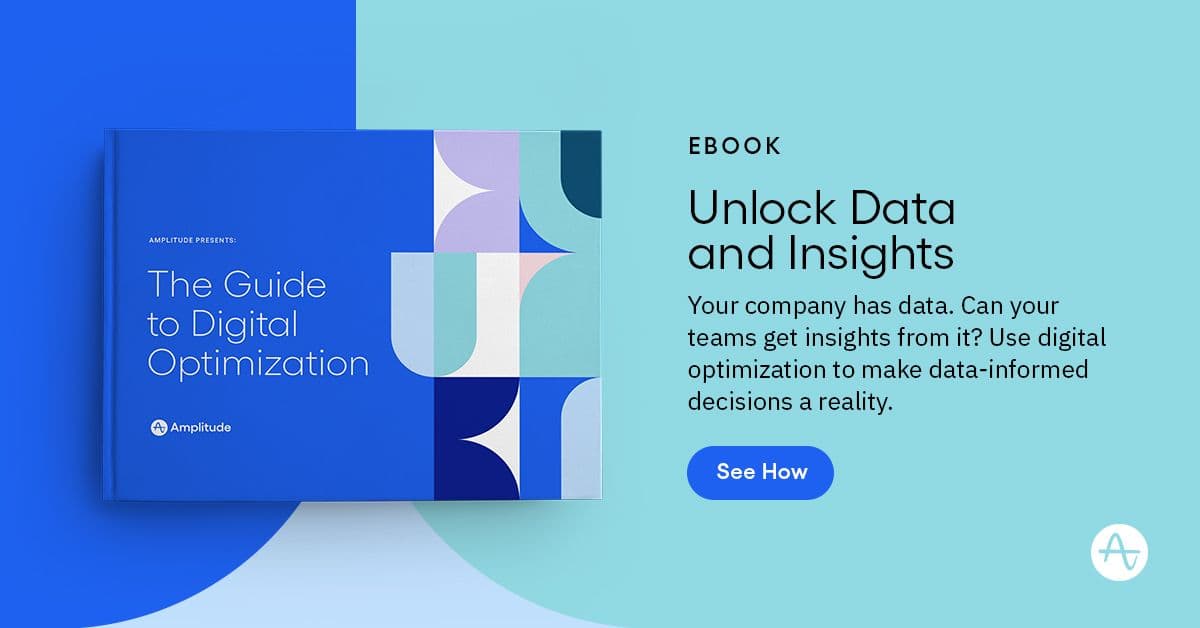6 Essential Digital Optimization Skills You Need
To succeed as a customer-centric team, building and honing digital optimization skills is crucial. Here are the skills to focus on.
Digital optimization is critical for driving sustainable business growth with product data. But what does it mean to operate with digital optimization?
A digitally optimized company empowers every customer-centric team to explore product data, gather technological insights, and take immediate action to drive toward business outcomes. Oftentimes, these identified outcomes are centered around driving long-term customer loyalty and value.
Executed properly, digital optimization should:
Increase
- Customer lifetime value
- Transaction efficiency
- Employee retention
- Speed to market
- Differentiation
- Expansion/available market
Decrease
- Risk
- Cost of acquisition
- Volatility
- Customer retention costs
Getting to this dream state requires a key set of skills and principles. Digitally optimized teams should be product-led, collaborative, data-driven, and iterative. It’s the duty of company leaders to ensure employees have access to the same data across different teams so that these teams develop a shared understanding of customer behavior across multiple views.
Ultimately, digital optimization won’t be successful without a visionary leader to spearhead the charge, which requires a change management approach to people, processes, and technology.
Below, we’ve listed six essential skills that executives and practitioners alike need to enact digital optimization, as well as what tools can be used alongside your digital optimization efforts. To learn more about this concept, check out The Guide to Digital Optimization.
Why digital optimization matters
The customer journey has changed dramatically, and there’s been an overhaul to worldwide data processing that impacts how businesses can collect data. Therefore, your digital strategies have to evolve to meet up with these changes.
The digital optimization process includes gathering and reviewing first-party product data to understand customer insights, and using that data to subsequently improve the customer experience. Digital optimization helps digital-facing teams (like product and marketing) come up with strategies that create better business outcomes.
Your business has to make sure it’s consistently delivering great digital experiences that offer value. Otherwise, your business will lose customers. But delivering great customer experiences is easier said than done, especially in a time when customer expectations are higher than ever. With a digital optimization system, you are able to analyze customer data and understand in-depth how customers are interacting with your product. Armed with these insights, you can set out to create better experiences for your users.
6 essential digital optimization skills for 2022
Digital optimization requires specialized skills. Here are six essential digital optimization skills to get you started.
1. Customer-centric mindset
A customer-centric mindset directs your product and service iteration to focus on providing a better experience for your customers. Teams need to ensure that decisions surrounding the product or company are made with the customer in mind.
This also means that you need to understand and be aware of key customer metrics, such as:
- Lifetime value (LTV): Understand how to drive long-term value for critical customer cohorts.
- Conversion rate: Know which stage of the customer journey has the highest conversion rates and how to improve conversion rates at other stages.
- Customer retention rate: Know how many customers your business retains over time, and which digital experiences impact retention.
- Churn rate: Understand how many customers stop using your product or service and how this can be decreased.
2. Product-led mindset
Any digital optimization strategy must consider how the product—the focus of customer interaction in this digital world—drives growth.
We’re not just talking about renewals, here. With product-led growth, your product becomes a sales driver of its own—selling new customers on the immediate value it provides and encouraging new customer adoption through low-sales motions like a free trial or freemium experience.
While not every company can supply a freemium or free trial experience (though we encourage you to make the case for it), you can still embrace a product-led mindset. As product coach John Cutler puts it:
“Product-led means being guided by the potential of products and product teams, and breaking down the silos between ‘the business’ and ‘the product.’ The business IS the product.”
Working with a product-led mindset means thinking critically about how your product actually drives growth—and building for that value. In practice, this can look like avoiding the trap of the feature factory and establishing a North Star to drive product vision and strategy.
3. Data-driven mindset
Having a data-driven mindset means trusting the integrity of the data and including product data in planning operations and strategy processes.
Proactively use the data to make the right decisions at the right time. For instance, use insights from customer data to justify why it’s the best time to release a new product feature. Data is used to make decisions and validate theories that help you understand the problems in your product or service.
Having a data-driven mindset also ensures that customers get the best customer experience. The data that you have access to highlights user behavior. With that user behavior data, you gain more insight into how a customer interacts with your product and what deters them from completing a certain experience. All of this information helps you build products that are more aligned with customer expectations.
4. Agility
Digital optimization requires companies to be able to keep up with constantly changing demands and take quick action based on insights.
Teams need the support and flexibility to reevaluate decisions based on what the product data reveals. They also need to be agile to launch experiments, share findings, and take action based on timely opportunities.
Another key aspect of digital optimization agility is investing in technology that supports best-in-class integrations. Teams need to adapt their technology stack to ensure that the technology is also agile and can adapt to industry-wide changes, like data processing changes.
5. Collaboration
The same first-party data can service many different teams—product, marketing, engineering, analytics, customer success, and executive. However, teams aren’t always looking at the same data. So it’s important to share relevant insights across the organization. Collaboration also helps break down data silos across teams and identify opportunities for growth that may not have been thought of before.
Additionally, collaborating across teams can help with data problem-solving. Sometimes, an extra set of eyes and an extra mind can be helpful in explaining any discrepancies in the data.
6. Change management
Teams need to be able to adapt to newer strategies and processes. Changes involved with a digital optimization effort can include rethinking metrics, adjusting KPIs, and modifying technology access to support data democratization. These changes can impact the way an organization operates, so it’s important to think through and manage expectations for those adjustments.
Teams need to be well prepared and supported through any changes that may take place. It’s important to ensure everyone is kept up to date and any changes to their KPIs and objectives are clearly communicated.
Recommended tools for digital optimization
Businesses will often use an ecosystem of integrated tools to provide access to product data across various functions. Tools such as Braze and Amplitude are good examples.
While Amplitude is the pioneer of the digital optimization category, it is not the only company that provides digital optimization software. However, Amplitude is the only digital optimization system that has all the core capabilities. These factors include:
- A behavioral-based, cross-platform system with:
- Real-time, intelligent insight
- Complete, trustworthy data
- Products that are:
- Collaborative and self-service
- Integrated and open
- Designed for enterprise scalability
From capturing the right data to experimenting and personalization, Amplitude has the capability to optimize and enhance every customer’s experience.
Continue expanding your digital optimization skillset
As customer expectations for digital experiences rise, you need to expand your digital optimization skillset—before your competitors do. Learn how to put product-led, data-focused strategies into place with the Guide to Digital Optimization today.

Mallory Busch
Former Senior Content Marketing Manager, Amplitude
Mallory Busch formerly ran the Amplitude blog, frequently named a best blog for product managers. She also created AmpliTour, the live workshop for beginners to product analytics and 6 Clicks, the Amplitude video series. She produced the Flywheels Playbook, wrote The Product Report 2021 and produced The Product Report 2022. A former developer and journalist, Mallory's written work and coding projects have been published by TIME, Chicago Tribune, and The Texas Tribune. She graduated from Northwestern University.
More from Mallory





